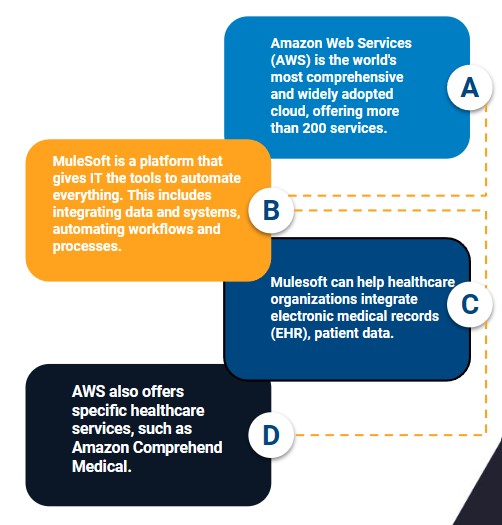In the changing technological landscape, there are tools that are positioning themselves as the most used by companies and all types of people due to their multiple functions, characteristics and benefits that they provide when used in internal and work processes, this is the case of MuleSoft and AWS.
MuleSoft, as explained in an article published by Salesforce, “is a platform that gives IT the tools to automate everything. This includes integrating data and systems, automating workflows and processes, and creating incredible digital experiences, all in a single, easy-to-use platform. With our unique approach, IT creates the digital building blocks that teams can use as needed, all with the appropriate security, governance and compliance measures built in.”
For its part, AWS “is the world's most comprehensive and widely adopted cloud, offering more than 200 full-featured services from data centers around the world. Millions of customers (including the fastest-growing startups, largest enterprises, and major government agencies) use AWS to reduce costs, be more agile, and innovate faster,” according to what is explained on its official website.

Mulesoft use cases in the business world
Application integration
MuleSoft helps integrate multiple applications within an organization, allowing them to communicate and share data in real time. This can include connecting CRM systems, ERP systems, databases, and other business applications.
Data integration
MuleSoft makes it easy to integrate data from multiple sources, transforming and combining them to provide a unified view. This is particularly useful for creating data warehouses, business intelligence, and analytics solutions.
API management
MuleSoft provides robust API management capabilities, allowing organizations to create, publish, and manage APIs. This is crucial to allow third-party developers to securely access and use specific functionality or data.
Cloud integration
Organizations typically have a mix of on-premises and cloud-based applications. MuleSoft can be used to integrate cloud services, ensuring seamless communication between on-premises and cloud environments.
Legacy System Modernization
MuleSoft can connect legacy systems with modern applications and technologies. This is essential for organizations looking to modernize their infrastructure without discarding existing investments in legacy systems.
eCommerce integration
MuleSoft can be used to integrate e-commerce platforms with other systems, such as inventory management, order processing, and customer relationship management systems.
Mobile app integration
MuleSoft allows the seamless integration of data and services required by mobile applications. This ensures that mobile apps can access the necessary backend systems and provide a seamless user experience.
Internet of Things (IoT) Integration
MuleSoft can be used to connect and manage data generated by IoT devices, integrating it with other business systems for analysis and decision making.

AWS Use Cases for Business
Website Hosting and Content Delivery
AWS provides a scalable and reliable infrastructure for hosting websites and web applications. Amazon CloudFront, AWS's content delivery network (CDN), ensures low-latency content delivery to users around the world.
Data storage and backup
AWS offers scalable and durable storage solutions through Amazon S3 (Simple Storage Service) for object storage, Amazon EBS (Elastic Block Store) for block storage, and Amazon Glacier for long-term archiving.

Computing power
AWS Elastic Compute Cloud (EC2) enables businesses to quickly provision virtual servers, scale compute resources as needed, and run applications in a secure, scalable environment.
Database services
AWS provides managed database services such as Amazon RDS (relational database service), Amazon DynamoDB (NoSQL database), and Amazon Redshift (data warehouse). These services simplify database management and improve scalability.
Machine learning and artificial intelligence
AWS offers a suite of machine learning services, including Amazon SageMaker for building, training, and deploying machine learning models, and services such as Amazon Comprehend for natural language processing and Amazon Rekognition for image and video analysis.
Internet of Things (IoT)
AWS IoT services help businesses securely connect and manage IoT devices, ingest and analyze IoT data, and build applications that interact with IoT devices.
Analytics and Big Data
AWS provides tools such as Amazon EMR (Elastic MapReduce) and Amazon Athena for big data processing and analysis. Amazon Redshift is a fully managed data warehouse for running complex queries and analysis.
We recommend you on video

